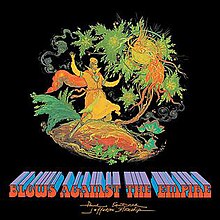Blows Against the Empire
| Blows Against the Empire | |||||
|---|---|---|---|---|---|
 |
|||||
|
Studio album by Paul Kantner and Jefferson Starship |
|||||
| Released | November 1970 | ||||
| Recorded | Fall 1970 at Pacific High Recording and Wally Heider Studios, San Francisco | ||||
| Genre | Folk rock, progressive rock, proto-punk, psychedelic rock | ||||
| Length | 41:41 | ||||
| Label | RCA Victor | ||||
| Producer | Paul Kantner | ||||
| Paul Kantner chronology | |||||
|
|||||
| Jefferson Starship chronology | |||||
|
|||||
| Professional ratings | |
|---|---|
| Review scores | |
| Source | Rating |
| Allmusic | |
| Robert Christgau | C+ |
Blows Against the Empire is a concept album by Paul Kantner, released under the name Paul Kantner and Jefferson Starship, the first album to use the "Starship" name, although the personnel line-up was not the same as would appear on the first actual Jefferson Starship album. It was released in 1970 as RCA Victor LSP-4448. It peaked at #20 on the Billboard 200, and has been certified a gold record by the RIAA. It was the first rock album to ever be nominated for a Hugo Award.
Beginning in 1965, Paul Kantner had recorded five studio albums with Jefferson Airplane, but by 1970 internal problems began taking their toll on the band, including the departure of drummer Spencer Dryden in 1970 and a rift that was forming between founder Marty Balin and the rest of the band that would lead to Balin's departure in Oct. 1970.
In 1970, the Airplane released only one single, and Kantner took advantage of the hiatus to work on a solo album. Blows Against the Empire is his concept album recorded and released in 1970, credited to Paul Kantner and Jefferson Starship. This marks the debut of the Jefferson Starship moniker, though not of the band of that name itself, since Blows predates the actual formation of the band Jefferson Starship by four years.
A small number of promotional copies of the album were released to radio stations on clear translucent vinyl. These are now coveted by vinyl record collectors.
The album was recorded at Pacific High Recording Studios and Wally Heider Recording Studios in San Francisco by Kantner and Slick with a collection of musician friends that included members of Jefferson Airplane (Jack Casady and Joey Covington), The Grateful Dead (Jerry Garcia, Bill Kreutzmann and Mickey Hart), Crosby, Stills, Nash & Young (David Crosby and Graham Nash), David Freiberg of Quicksilver Messenger Service and Harvey Brooks of Electric Flag. Also appearing was Jorma Kaukonen's brother Peter Kaukonen, and Phill Sawyer, the engineer at Pacific High Recording studios. The credit to Jefferson Starship reflected many things – the ad-hoc all-star line-up, the album being an evolutionary progression from Jefferson Airplane, and finally the story it relates of the hijacking of a starship.
...
Wikipedia
